It’s all in the name… Sentinel. A Sentinel is a guard whose job it is to stand and keep watch. The Faxon Firearms Sentinel will do just that… keep watch… overwatch, that is. The AR-15, no doubt, is America’s favorite rifle. But even America’s rifle has its limitations. The primary limitation is that it cannot handle long-action cartridges such as the 8.6 Blackout.
The standard 5.56 NATO cartridge loses a lot of velocity and power at a distance. So to get over that hurdle but still have the same feel of an AR-15, you’re looking at an AR10.
The AR10 has the same look and feel as the AR-15. But you can now shoot longer action cartridges such as the 8.6 Blackout, .308 WIN, and 6.5 Creedmoor.
The Sentinel 8.6 BLK, part of Faxon’s Summit Line of firearms, boasts a billet aluminum receiver set, G3 Aluminum Streamline M-LOK Handguard, new 8.6 Blackout MuzzLok Muzzle Device, and the impressive 1:3 twist Big Gunner Profile Barrel. Faxon’s Lifetime Guarantee also backs the Faxon Sentinel.
Faxon Sentinel 8″ 8.6 Blackout AR10 Pistol
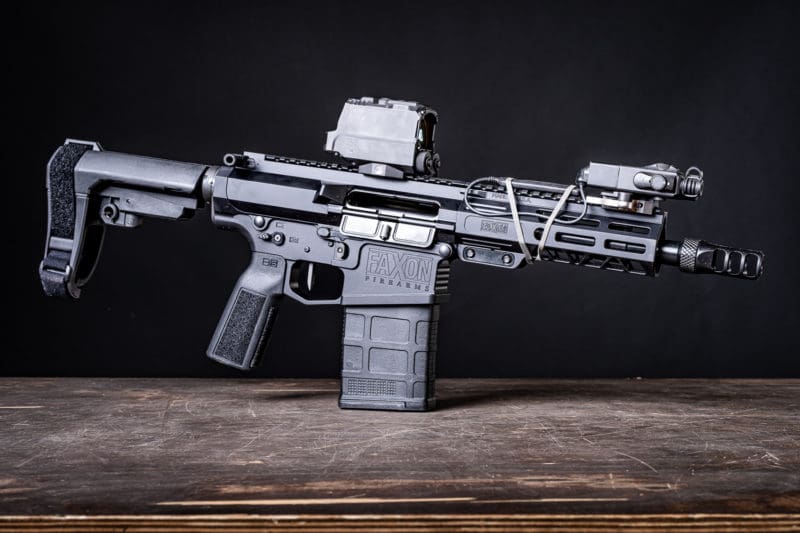
Specs
- 7075 Billet Aluminum Receiver Set
- Faxon 8″ 1:3 Twist Big Gunner Profile 8.6 BLK Barrel, 4150 CMV, Nitrided
- Faxon MuzzLok 8.6 Blackout 3-Port Muzzle Brake
- Faxon G3 Aluminum Streamline M-LOK Handguard
- Faxon G2 Superfinished AR10 BCG
- Faxon AR-10 Height Gas Block
- SBA3 Pistol Brace
- Faxon Trigger by Rise Armament
- B5 Pistol Grip
- Ambi Charging Handle
- Ambi Safety Selector
- Pistol-Length Gas System
Weight and Dimensions
- Weight: 6.59 lbs
- Length: 24.5″
- Depth: 7.5″
- Width: 2″
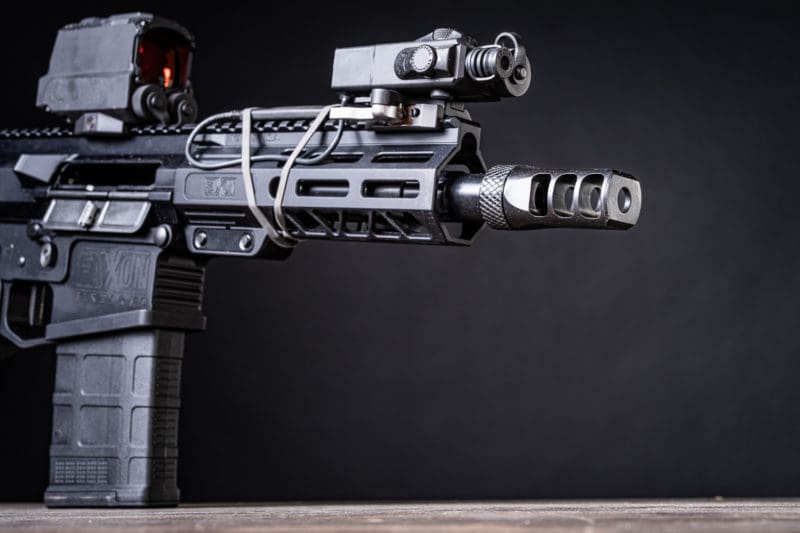
Faxon Sentinel 12″ 8.6 Blackout AR10 Pistol
Specs
- 7075 Billet Aluminum Receiver Set
- Faxon 12″ 1:3 Twist Big Gunner Profile 8.6 BLK Barrel, 4150 CMV, Nitrided
- Faxon MuzzLok 8.6 BLK 3-Port Muzzle Brake
- Faxon G3 Aluminum Streamline M-LOK Handguard
- Faxon G2 Superfinished AR10 BCG
- Faxon AR-10 Height Gas Block
- SBA3 Pistol Brace
- Faxon Trigger by Rise Armament
- B5 Pistol Grip
- Ambi Charging Handle
- Ambi Safety Selector
- Pistol-Length Gas System
Weight and Dimensions
- Weight: 7.87 lbs
- Length: 29.25″
- Depth: 7.5″
- Width: 2
Faxon Sentinel 16″ 8.6 Blackout AR10 Rifle
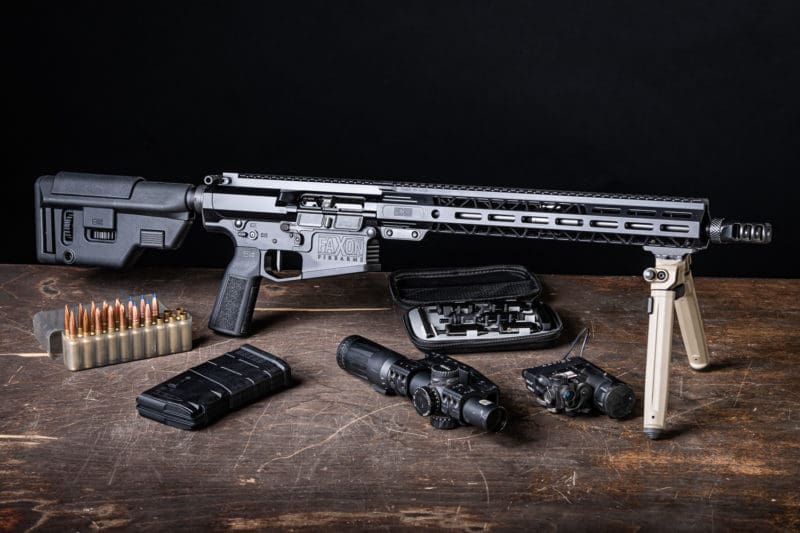
Specs
- 7075 Billet Aluminum Receiver Set
- Faxon 16″ 1:3 Twist Big Gunner Profile 8.6 BLK Barrel, 4150 CMV, Nitrided
- Faxon MuzzLok 8.6 Blackout 3-Port Muzzle Brake
- Faxon G3 Aluminum Streamline M-LOK Handguard
- Faxon G2 Superfinished AR10 BCG
- Faxon AR-10 Height Gas Block
- B5 Precision Collapsible Stock
- Faxon Trigger by Rise Armament
- B5 Pistol Grip
- Ambi Charging Handle
- Ambi Safety Selector
- Carbine-Length Gas System
Weight and Dimensions
- Weight: 9.33 lbs
- Length: 36″
- Depth: 7.5″
- Width: 2″
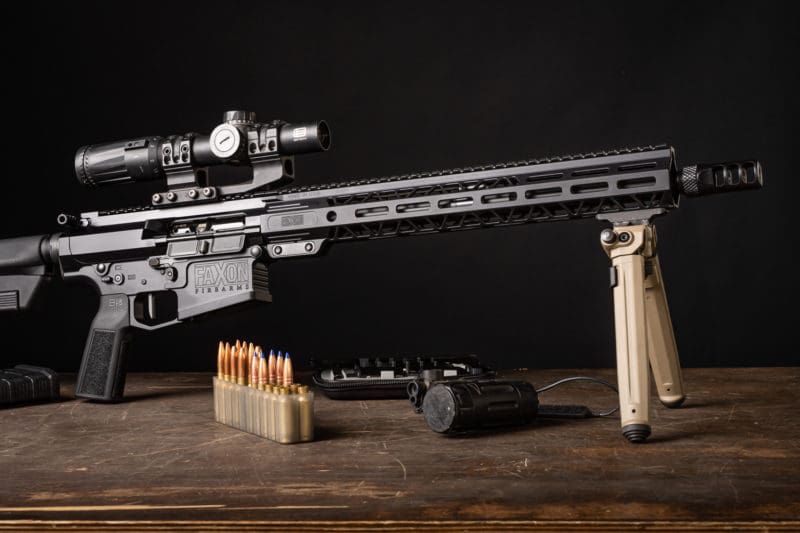

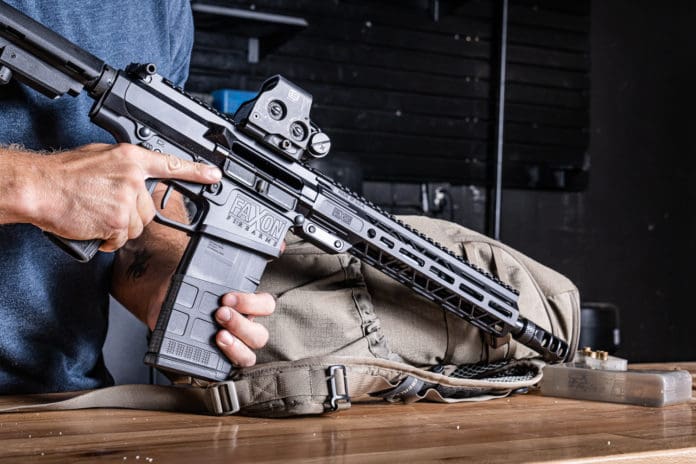



I just don’t understand why we need another new cartridge. Especially, since we’re still in a bit of an ammo crunch. Logistics.
Exactly. While I admit I’m intrigued by this fat 8.6 BLK, I note that the mfr offers three barrels in very different lengths of 8″, 12″, and 16″. So for which length, exactly, is the 8.6 BLK optimized for? If a standard 5.56 is best suited for a 20″ barrel, and .300 BLK is designed for a 10″ with suppressor (and a heavier 220g bullet), then should 8.6 BLK even be offered in 8″ pistol if this article is touting the cartridge as an alternative for long distance?
Need more info, plz.
1-in-3″ barrel twist has to be the tightest I’ve ever heard of.
Must be really heavy bullets at a very low velocity for such a twist rate.
Yeah, I kept scrolling down, looking for a long barrel with which to reach out and touch someone. It doesn’t seem reasonable to me, to start out talking about long range, then limit the discussion to carbine and pistol barrels.
“I just don’t understand why we need another new cartridge.”
Preach it.
A big part of the allure of .300BLK (to me, anyways) was the fact that brass could be manufactured at home by re-sizing 5.56 NATO brass.
That needs 6.5 Creedmoor brass, no where as common as 7.62 NATO brass.
If it were to use 7.62 NATO as a base brass, caliber change could be as simple as it is converting a 5.56 AR-platform into .300BLK.
Just a barrel change. Bolt stays the same, magazines as well.
Was there a particular reason why 7.62 NATO brass was unacceptable for this project?
Bolt and magazine stay the same with the 308 and the 8.6BO as well. Think of the 8.6BO as a subsonic focused 338Fed.
Brittingham wanted the shoulder angle of the Creedmoor, not the .308Win.
6.5CM can be made from 308 and 8.6BO can be made from 6.5CM. So, although it’s more processing than I’m interested in, 8.6BO can be made from 308.
Ah, OK, thanks.
In a round-about way, it is .308 based (kinda).
The largest caliber I currently own is .300 BLK. This sounds like something to consider on down the line…
My understanding is 7.62 x 51 brass can be converted to 6.5 Creedmoor. https://www.armorally.com/lake-city-762-creedmoor-conversion/
So much of business, any employment scheme really, is creating a need so that you may provide for that need.
The ATF, IRS, CIA, DMV were never needed but now that we have them we can’t live without them.
Same goes for the private sector manufacturing a thing nobody asked for so they can sell it to all the people their army of journalists and influencers convince need it.
Eventually, with the exception of government created compulsory “needs”, time and budgets put to death products with no genuine utility or value but until that happens it’s cha-ching for the company producing the product.
The analogy to federal agencies is erroneous. This is a commercial good created and marketed in the private sector. It will sink or swim on the merits of the product.
The gov’t forcing “needs” on the people is an entirely true disgrace.
My theory: an ammo crunch is the perfect time to introduce a new caliber.
1. Introduce it, market the snot out of it. Focus on the capabilities this cartridge offers ahead of competing cartridges.
2. Produce it like crazy, the guns and the ammo. Devote limited machinery to producing it at the cost of producing more common legacy calibers. At first, there’s little demand for it compared to legacy calibers. So it’s perpetually on the shelf.
3. Customers see the guns and ammo on the shelf during every visit, at reasonable prices, and start wondering if that caliber would work for them. Maybe to replace an existing caliber or better fill a niche capability. It’s obviously available when others aren’t.
4. Let demand grow and keep production cooking (out of proportion to demand) for a year or two. Keep prices reasonable and availability high. Consumers consume and get their buddies onboard.
5. The new caliber is now ingrained into some segment of the consumer market.
6. Scale back to regular production, the same as legacy calibers. When the market normalizes, consumers now have a choice of the new hot caliber or an existing one. Either way, the companies sold guns and ammo, and will likely continue to sell to those that appreciated the new capabilities of the new caliber.
.204 Ruger fizzled. It wasn’t new or in massive production when 2020 hit. I rarely saw it on the shelf. Companies devoted small rifle machinery to producing other calibers that sold.
.350 Legend was introduced in 2019 (I think). While unplanned, the timing of 2020 and .350 Legend availability probably led to a lot more guns and ammo sales than if 2020 hadn’t happened.
The next experiment will be .30 Super Carry. It has merit on its own, and it was introduced squarely in the middle of the ammo crunch. For many, it’s an appreciable gain over .380 or 9mm or both. I expect it to do well.
It’s an unfalsifiable theory because we can’t go back in time and re-introduce a caliber with all the same variables (capability, platform options, marketing, availability, consumer cost) and only change the market environment. But I think the theory works.
“My theory: an ammo crunch is the perfect time to introduce a new caliber.”
IMHO, why .300 BLK was an ideal new caliber.
Literal *mountains* of 5.56/.223 brass resided in 5-gallon pails in homes across the land, ready to be formed into the new round at the modest expense of resizing and trimming the brass. Just a new barrel needed to fire it. Same base rifle, same magazines.
This new one looks like having similar characteristics, but from the AR-10 instead it’s little brother…
Has the 8.6 BLK been accpeted by SAAMI yet?
Not yet.
As far as I am concerned, doesn’t matter. I’m fine with wildcat’s. On the other hand, I also won’t be the first kid on the block to invest in one either. I like my face right where it’s at, attached to my skull.
Besides, SAAMI is a way too conservative safety nanny, the veritable fun police that never lets anyone have any fun.
“Besides, SAAMI is a way too conservative safety nanny, the veritable fun police that never lets anyone have any fun.”
That very well may be why you still have a face… 🤣
Amen.
They downgraded the CIP approved .300 Whisper to by 10k psi to get .300 B.O. SAAMI approved (iirc, can’t find anything on the load data anymore which seems to have been wiped from the web, even CIP’s original cert documentation). Which is otherwise the exact same cartridge.
No one ever had a chamber erosion problem on Whisper, which was around for well over a decade and a half before AAC stole the design and pushed for certification.
And there are a plethora of legit like wildcat rounds, including my non-CIP/non-SAAMI Rowland that run as flawlessly as any SAAMI approved round. Summed; their word is not the law, and shouldn’t be taken as though from on high. Despite what the indoc camps mind manipulations would have you believe. 😉
Outside the box folks, think it.
My buddy loads hot 10mm but doesn’t go past recommended maximums in the books. I’m not familiar enough with reloading to go beyond what is said to be safe in say a Hornady or any powder manuals.
“The standard 5.56 NATO cartridge loses a lot of velocity and power at a distance.”
I knock down target at 400 meters!
How much more power do you need for home protection?!!?
What is the weight of the target? 150-200lb?
The rifle version weighs north of 9 pounds with out glass.
For a time there we overdid the super light rifles. Now we seem to have went too far in the other direction.
I thought I misread that as well as the 7 odd pounds for the 8 inch pistol. Well standard 308 AR 10 for me. Admittedly more because ammo is available and not too crazy priced (also easy to reload) but also no way to make use of suppressors here in NY. Neat idea but I think the weight and overall comparison to 300 aac could relegate this one to hunting/pest control.
1:3 is some seriously fast twist – wonder what barrel throat life is like.
I thought throat life was more dependent on ‘hot’ charge pressures?
Wouldn’t barrel lands be more impacted on by a faster twist rate?
Or did I pick another bad time to quit sniffing glue? 😉
You’re right about pressures wearing everything out faster, but the throat is always disproportionately affected partly because the rifling there is forcing the bullet to the full twist rate basically instantly. Relatedly see progressive- or gain-twist rifling which (though *very* rare in small arms) tries to address this.
Rare, to be sure, but, Carcano.
@MyName – didn’t know that one! The .460 S&W revolvers are the only modern ones I was aware of.
Forgot for a moment about the .460 – I think that is the most current example. Yup, the Carcano, at least the early ones, were gain twist. It is, when you get down into the engineering of it all, an interesting and potentially useful idea. The manufacturing difficulties and costs are, however, substantial.
As a side note, why is the .460 gain twist but the .500 isn’t? I honestly have no idea.
Eric in OR hit on part of my question – that super fast rate and the immediate engagement of the rifling and, thereby, high resistance stress, pressure, and load on both bullet and barrel, lead/can lead to pressure spikes and wear in that very violent area that exists between the end of the cartridge and the start of the rifling. Essentially, any time you use mechanical methods to re-direct force, the impact of that concentration of force is highest at the point of first mechanical engagement. Consider, for instance, riding a bicycle along a flat road and then hitting a slope of 10%. Imagine how much more resistance you would feel if that slope was 30%. (A factor of 3 difference being similar to how much steeper this pitch is than rates more common, like 1:9 or 1:10, in modern rifles of similar caliber.)
Cool rifle. I’ve never heard of this chambering, tho. Doubt I’ll see it in the north woods of Maine anytime soon.
My two go to’s in the AR platform.
AR 15 in 556, and AR 10 in 308
Both are common cartridges and there is more reloading data on these than you can shake a stick at.
I want one.
Well, me too but, my ultimate goal is, “One of each.” I may not be an objective voice on the matter.
Interesting round. I’d honestly consider it, but there’s always some new round always coming out and they’re always short lived. The last decade has seen so many new rounds come out it’s ridiculous and I’ve never actually seen anyone in real life with the vast majority of them. I never see any of them on shelves or available online either.
5.56/.223 is fine for 99.9% of MSR/AR pattern type rifle people. Not many are going to be making 200-300 yards or longer shots in a hunting or defense mode but I guess it could happen.
I’ll repost my last reply and add “weight” and “bulk” to the “what else do you really gain” category which I forgot.
>300gr at 1070fps is 763 ft-lbs. I realize this is a suppressor focused round but I still think >its really nichey. Assuming it stabilizes at 200 yards the difference between a .750 bullet >and a .130 bc bullet is about 9 inches drop.
>Why not 458 SOCOM? What do you really gain besides weight and cost?
To add a bit more to this even, Cutting Edge makes a .2 BC .458 SOCOM bullet. You’re down 3″ more drop (under 10%) with it in a subsonic load and you’d be about 300 ft-lbs down in energy which is the big loss. That’s only subsonic though and you’re still making .357 mag muzzle energy at that distance. I also question the liklihood that it’s supersonic viable at this moment. Supposedly super aggressive twists can chew on bullets, I’d be curious to see where supersonic load development with this round is at. I saw one site that had it listed but it seems like vaporware.
The whole thing seems like a super particular set of circumstances and extremely nichey while using pricey .338 bullets even if it lets you use .308 or creed brass to make your cases. At least 300 BLK would let you use surplus .308 bullets. I’m really doubting they sell a lot. From a reloading standpoint black at least had a reputation of being finicky in terms of getting a gun to run in all circumstances with any given load (e.g. sub/super can/no can.)
If you guys can get one I’d be curious to see what the review looked like. Not sure that they’d send you another gun to review after though!
Spin projectiles too fast and they turn into “grey mist” about 20-30 yards or so from the muzzle.
.meht gnikam si enoyreve, seenk seeb eht be tsum yllaer smnug elyts RA mehT
Ecko getrykus, Marsupial One?
Can a possum have a stroke?
So tired of them creating new cartridges when they can’t even shelve old ones.
.375 Raptor has better subsonic performance, uses .308 brass and also has some really stompy supersonic loads nipping at the heels of .375H&H performance. Far more versatile IMO.
Well got something to research this week, thank you.
Need vs want is relative!
https://youtu.be/Bpg1ZKVnNSM
They’re always trying to come up with a better mouse trap all the bullets do the same thing make holes in paper or kill some do it better than others some like great less recoil while others go for the Big bang. Toys that were designed and built in 1800s still work well and do the same thing new and improved of fun if you can afford it. Variety is the spice of life it might be necessary if everything is disapproved by government entities and illegal to own in the near future new toys and ideas are great for the industry and build a better product so the pluses and minuses to everything. One thing they can’t replace is the excellence of a shooter. One shot one kill and your point is well taken.
I had an old Winchester in .264 Magnum, they were pretty popular out on the prairie in Kansas for Coyote’s. Depending on the load and Bullet used they would come apart prior to a 100m. I believe that was a necked down .458 belted cartridge. Great gun.
Comments are closed.